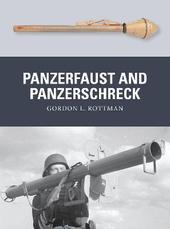
|
Panzerfaust and Panzerschreck
Paperback / softback
Main Details
| Title |
Panzerfaust and Panzerschreck
|
| Authors and Contributors |
By (author) Gordon L. Rottman
|
|
Illustrated by Johnny Shumate
|
|
Illustrated by Alan Gilliland
|
| Series | Weapon |
|---|
| Physical Properties |
| Format:Paperback / softback | | Pages:80 | | Dimensions(mm): Height 248,Width 184 |
|
| Category/Genre | Second world war |
|---|
| ISBN/Barcode |
9781782007883
|
| Classifications | Dewey:355.80943 |
|---|
| Audience | |
|---|
| Illustrations |
50 b/w; 13 col
|
|
Publishing Details |
| Publisher |
Bloomsbury Publishing PLC
|
| Imprint |
Osprey Publishing
|
| Publication Date |
20 August 2014 |
| Publication Country |
United Kingdom
|
Description
Two of World War II's most distinctive weapons, the Panzerfaust and Panzerschreck offered German and other infantrymen the ability to destroy enemy tanks singlehandedly at close ranges. While the Panzerschreck owed its origins largely to the US bazooka, the Panzerfaust was a revolutionary design that was unlike any previous weapon, and went on to influence anti-tank technology and tactics for decades after World War II. Allied troops, notably Soviet forces, made widespread use of captured Panzerfauste, and they were also supplied to German allies such as Finland, Hungary and Bulgaria. Written by an expert on anti-tank warfare, this book reveals the fascinating development history of these two feared weapons and assesses the tactics that were employed by the soldiers using them.
Author Biography
Gordon L. Rottman entered the US Army in 1967, volunteered for Special Forces and completed training as a weapons specialist. He served in the 5th Special Forces Group in Vietnam in 1969-70 and subsequently in airborne infantry, long-range patrol and intelligence assignments until retiring after 26 years. He was a Special Operations Forces scenario writer at the Joint Readiness Training Center for 12 years and is now a freelance writer, living in Texas. Johnny Shumate works as a freelance illustrator living in Nashville, Tennessee. Most of his work is rendered in Adobe Photoshop using a Cintiq monitor. His greatest influences are Angus McBride, Don Troiani, and Edouard Detaille. Born in Malaya in 1949, Alan Gilliland studied photography/film and architecture, and has worked as a photojournalist and cartoonist. He also spent 18 years as the graphics editor of The Daily Telegraph, winning 19 awards in that time, including numerous UK Press Awards. He now writes, illustrates and publishes fiction (www.ravensquill.com), as well as illustrating for a variety of publishers (including Osprey, the Penguin Group, Brown Reference Group, Ivy Group and Aurum), architects and developers, such as John McAslan (Olympic Energy Centre) and Kit Martin (Prince Charles' Phoenix Trust advisor on historic buildings). www.alangilliland.com
|